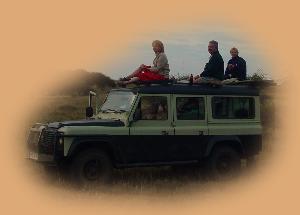| | | |
Temperature Variations Throughout the Day |
It is generally believed that Equatorial countries are hot which does apply at the coast.
However many of the safari parks are situated in higher areas c. 5,000 feet above sea level, where temperatures can be much cooler. It will be quite chilly on dawn game drives until the early morning mist and clouds have been burnt off. If you stand-up as you drive along you'll also have to contend with the wind-chill factor. At other latitudes e.g. South Africa temperatures at night can fall close to 0°C. We've been caught out a couple of times and have been known to put 3 layers of clothing on, wrap ourselves in blankets and use lined ponchos just to keep warm. In these circumstances don't forget to keep your camera batteries warm, otherwise they may only give you a few minutes operation!
Usually by midday and throughout the afternoon temperatures will be quite hot, but once the sun goes down c. 18:15 (6:15 pm) the temperature will fall quickly again.
|

Sundowners. Chyulu Hills.
17th Jun. 2004 |
|

Adamson's Falls. Meru.
31st Dec. 2004 |
General Safari Wear
Over the years we've gradually migrated to specialist safari wear, consisting of :
- Light weight, light coloured (we're English!), open-necked shirts with a mixture of long and short sleeves.
- Light weight, light coloured safari trousers with 'zippy' legs which can be removed to wear as shorts.
The above are all easily washed by hand or through the lodge's laundry.
|
These are supplemented with :
- Trainers with socks, as you never know when a short walk may be on the cards.
- Long sleeved jumpers or light sweat-shirts which can be removed once the temperature rises.
- Baseball caps or wide brimmed hats to protect from the sun. Hats should be tight fitting ( if you can stand it ) or have a chin strap, so it doesn't blow off in the wind.
- Many tourists also use sun-glasses but I personally find these interfere with my 'spotting'.
|

Loisaba.
1st Jan. 2004 |
If special wear is beyond your means for a single safari then sensible light weight trousers and shirts would do, as long as you have the warmer clothes for early mornings and evenings.
Don't forget your sun-creams and drinking water! |
|
Clothes for Other Activities |
Obviously, specialist activities such as scuba diving, horse riding etc require their own attire which those with greater experience can advise on.
But bush walks are common and you may require more rugged footwear, such as walking boots (make sure they are worn in, otherwise you'll get blisters). These will stop rolling an ankle on rubble and prevent thorns penetrating your skin - these can be over an inch long! Long trousers are also advisable to stop grass cuts and thorn scratches. Wait-a-bit thorns will pull you back unless you're very careful.
|


